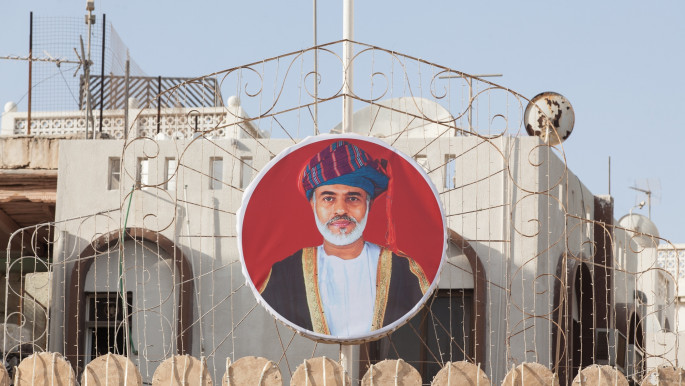Power and political imagery: Will Oman preserve Sultan Qaboos' portraits?
In turn, it has contributed to shaping the multifaceted image of the longest-serving Arab leader: moderniser, charismatic, diplomatic and authoritarian.
Researcher in political sociology Mubarak Al-Hamdani believes portrait to be one of the most important means of political communication to influence mental imagery. In Oman, they have "created the intellectual legacy of Sultan Qaboos", the Muscat-based expert said.
Following the death of Qaboos bin Said, a portrait of the late monarch will remain in every official building, hanging next to one of the new Sultan, Haitham bin Tariq. Omanis, who nicknamed Qaboos 'the founding father', say his image will live on, 'in their mind and hearts'.
'The central figure'
"Sultan Qaboos will always be looked at as the founder of our country. Whoever the ruler will be, he will try to associate himself with Qaboos bin Said," student Hajid Abdawani told The New Arab.
 |
Public portraits have shaped the multifaceted image of the longest-serving Arab leader: moderniser, charismatic, diplomatic and authoritarian |  |
During his childhood, Abdawani was inspired by portraits of Qaboos. "They would make me feel like I really want to meet him".
Over time, however, Sultan Haitham "will drive down these portraits from the streets, subject to political messaging necessities", public policy analyst Ahmed al-Mukhaini told The New Arab.
Although the new ruler pledged to continue Qaboos' legacy, he is also keen to develop a political image independent from his predecessor.
Recently, Sultan Haitham amended Oman's national anthem to remove the name of Qaboos bin Said from the lyrics. Experts expect the Omani leader to move the country to a faster pace of economic development, carry out structural reforms, boost non-oil industries and strengthen the country's fiscal position.
 |
|
| A portrait of Sultan Qaboos, the former ruler of Oman and longest-serving Arab leader. [TNA/Sebastian Castelier] |
Since the oil bust of 2014, Oman's public debt has been ballooning, from less than 5 per cent of the gross domestic product (GDP) to nearly 60 per cent last year.
In spite of the economic downturn, Oman's welfare system remained untouched under Qaboos' reign. The monarch believed austerity measures could trigger political unrest. But the double shock of the coronavirus pandemic and plunging oil prices leave the Omani government with very little room for manoeuvre while trying to assert Sultan Haitham's leadership.
The 2020 fiscal deficit is expected to be significantly higher than previously forecast, and all government agencies are ordered to cut their operating budgets by at least 10 per cent. Private companies can fire foreign workers, and austerity measures are around the corner.
Portrait culture
Across the Gulf, other leaders also have a deep political tradition of displaying their portraits to "anchor their legitimacy to the society they rule," said Ryan Bohl, a Middle East analyst at the geopolitical-risk firm Stratfor.
 |
Across the Gulf, other leaders also have a deep political tradition of displaying their portraits to anchor their legitimacy to the society they rule |  |
"These societies still have tribal influences that heavily value a personal connection to the state. So having an image of the leader helps build that connection," Bohl told The New Arab.
Moreover, Gulf states use political imagery as a tool to exert pressure on their populations. "The notion that a leader is always 'in' the room helps instil a sense of self-policing [...] Gulf citizens are always reminded that their leaders are, in a sense, always watching," Bohl said.
Most of the Gulf countries are ranked low in the World Press Freedom Index.
Until his death on 10 January, 2020, the well-respected Omani ruler was the prime minister, supreme commander of the Armed Forces, minister of defence, finance, and foreign affairs. In 2012, The Economist referred to Oman as "the world's most charming police state".
Sebastian Castelier is a journalist reporting on Gulf societies and Asia-Gulf migrations.
Follow him on Twitter: @SCastelier





 Follow the Middle East's top stories in English at The New Arab on Google News
Follow the Middle East's top stories in English at The New Arab on Google News


